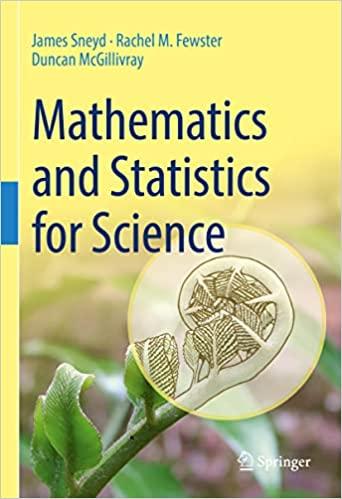For our final problem using Leslie matrices we use some real data on a wild rabbit population
Question:
For our final problem using Leslie matrices we use some real data on a wild rabbit population in England (Smith and Trout, 1994). Their motivation for the study was to determine how best rabbit populations can be controlled. The rabbit population was Rabbits (Oryctolagus cuniculus) are native to Spain and Portugal but have since spread widely around the world, becoming a major pest in a number of countries, including Australia and New Zealand.
divided into six age groups and the rate of reproduction within each age group was measured, as well as the probability of survival to the next age group. The data are shown in Table 11.3.
a. Let rn be the column vector of the six rabbit age groups, after 20n weeks. From the data, write a model of the form rn+1 = Arn, for some matrix A.
b. Suppose you start with a population of 100 newly-born rabbits. Use a computer to calculate r30 and r40. Is there any vector r∞ such that the population reaches a steady state, with r∞ = Ar∞? Interpret your answer in terms of the rabbit population.
c. Again suppose that you start with a population of 100 newly-born rabbits. As the population develops, what hapMore concisely, we write rn =
an bn cn dn en fn
.
pens to the relative numbers in each age group? For example, if an and bn are, respectively, the number of rabbits in the 0–19 and 20–39 age groups after 20n weeks, then how does an/bn behave as n gets large? What about the other ratios? What does this mean for the rabbit population?
d. Since rabbits are a pest we want to explore how the population can be controlled. In a simple control method, a certain fraction, which we’ll call f , of the rabbit population is killed in each 20 week period, and this fraction is the same for all rabbit age groups.
i. How would you model the rabbit population when this kill fraction is included? Hint: you still want to have a model in the form rn+1 = A( f )rn, for some new matrix A( f ) which depends on f . But where will f appear in A( f )? To help answer this, think, for example, about what the number 0.24
(top of the second column in Table 11.3) means. It means that 24% of the rabbit The last part of this question can most easily be done by trial and error; basically, you try a bunch of values for f to see if the rabbit population is increasing or decreasing after, say, 200 or 400 iterations. You won’t be able to derive an exact expression for f , but should get an answer close to 0.04. In other words, to control this rabbit population you would need to kill approximately 4% of the entire population every 20 weeks.
population in the first age group will proceed to the second age group after 20 weeks. How would you adjust this number to include a fractional kill of f ?
ii. Can you find a value for f that will (at least approximately) ensure a stable rabbit population that isn’t either growing or shrinking?
Step by Step Answer:

Mathematics And Statistics For Science
ISBN: 9783031053177
1st Edition
Authors: James Sneyd, Rachel M. Fewster, Duncan McGillivray






